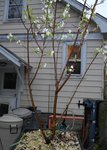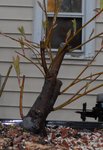I'm relatively early in my experiments with Amelanchier. Actually, if I were consistent in my care, I could be further along, but I did very little actual work on them. In 2014 I purchased 2 Amelanchier x Grandiflora 'Regent', the man made hybrid Serviceberry, (A. arborea x A. laevis) One parent, the downy serviceberry, A. arborea, is more tree like than most Amelanchier, can reach heights of 60 feet tall (rare but does happen), and trunk diameters to 6 inches or so. The other parent A. laevis, the smooth serviceberry, is also fairly tree like, not much smaller than the downy serviceberry. So you have a hybrid of two rather tree like species. I do want to correct something, in the Native Tree, Native Pot contest thread, I suggested Amelanchier x grandiflora is strictly a man made hybrid. I have since discovered it also occurs as a natural hybrid, as the range of the two parent species overlap. So for the contest, the answer is yes, x grandiflora cultivars may be allowed.
Most of the other serviceberries, but not all, most, are more shrub like in their growth habit. Large diameter trunks are very slow to develop. My initial thought was to experiment, with which is quicker. I took one nursery plant, did the radical root work needed to put it in an Anderson flat, without pruning the top. Then after the tree has recovered, the plan was to begin working the branches. The second I immediately did the "chop" and reduced it to a single trunk, then a year after the "chop" I repotted to an Anderson flat. I did not try the obvious third option, do the root work and chop all on the same day. At this point, I think doing the chop first, and root work the same day or later may actually be the "quickest" sequence to getting a pre-bonsai result. But I never followed up with much actual training. So this month we are at the 5 year mark since purchase. I don't have current photos, but both are alive and both look remarkably similar to the way they looked in photos 2 and 3 years ago. This is in part because I was too busy with the blueberry farm and other projects to do much work.
Also, growth is better in 3/4 to full sun. In shady locations, they tolerate the shade but do not grow much. Shade growth tends to be sparse and wispy. They are shade tolerant, unlike pines, they will "go on forever" in shade, but growth is better in 3/4 sun or higher sun. At least in my northern-midwest climate. Those of you in desert climates may find you need more shade. In areas where we get rain in summer, they do fine in full sun.
Actually, the Sept 2014 purchase was a group of 12 Amelanchier, all the same 'Regent' cultivar, and the rest were passed out to the Arbor Arts Collective Milwaukee Chapter study group. This attached photo shows 4 of them brought together at a 2015 meeting of AAC. You can see the smallest pot is the product of doing the chop and radical root work all at once. The one on the left pretty much had nothing done, and the one on the right was chopped with no repotting. You can see where it was "all done the same day" the product looks more bonsai like. Clearly young, only one growing season after purchase. Since they are all the same cultivar the comparison is a fair one.
View attachment 329738
Amelanchier are slow to "trunk up". Since they are a relatively small, graceful tree, or more commonly a shrub, it takes time to develop large diameter trunks. The trunk
@Tycoss has on his Serviceberry is definitely a very, very exceptional, and likely very old specimen. His Amelanchier is truly a rare gem for the species. The aged look does not come quickly to serviceberry. I think for practical purposes with the majority of species plan on trunks between one and 2 inches diameter, (2.5 to 5.0 cm) and not much more unless you collect them already a larger size. These small diameter trunks means they are best for shohin or slightly larger than shohin bonsai, not really for larger bonsai trees. Bark on young trees is smooth, much like the bark of a beech or an American hornbeam. Leaves are not overly large and reduce well with ramification.
View attachment 329740 &
View attachment 329741
Flowers open in spring, buds emerging before the leaves, and opening fully before leaves finish expanding. So there are leaves and flowers present at the same time, but the leaves will only be partially expanded about the time the flowers are finishing. In other words, flowers will look good and be a prominent feature for your spring bonsai display.
View attachment 329742
Fruit ripen early to middle summer, depending on latitude, 3rd week of June in Chicago-Milwaukee area. Fully ripe is purple. Some species fully ripe fruit is red. Most fully ripe fruit is purple or blue-purple. Fruit is sweet, apple like, seed is soft usually chewed and eaten with the fruit, and gives a mild almond flavor to the apple like flavor of the flesh. The fruit is not as moist as an apple, so if you each more than a handful, you may want water available. A significant food for First Nations people, there are some limited attempts to develop Amelanchier as a commercial orchard crop.
View attachment 329743
The above (click for full image) is my "root work first" Amelanchier 'Regent' in front of Irene's landscape 'Regent'. To give you an idea of what they look like in the landscape. An April 2017 photo. Both are the same cultivar.
View attachment 329737
Autumn color is fair to pretty good, usually yellows, oranges and reds, sometimes on the same tree. Some trees will have mostly yellow, some more red.
View attachment 329745 &
View attachment 329740
My root work first Amelanchier. Fully 6 years after purchase, I still have not gotten around to "making the chop". Don't know why, other than I keep thinking I love the flower display.
My chop first root work following year Amelanchier. On this one, it has not flowered since the "chop" of the trunks. I know it will eventually, but 4 years post chop, it still has not resumed flowering. Don't know if this is a good sign or a bad sign, or just my less than ideal horticulture.
View attachment 329744
This pretty much sums up everything I know about Amelanchier. I have not "pushed" them to become bonsai, been too busy with other things. All in all, what I've seen they seem EXCELLENT for smaller size bonsai, or if you get a big trunk as
@Tycoss was able to, you can go larger if the trunk size allows you to do so.









